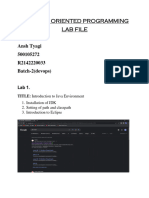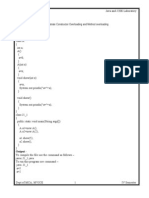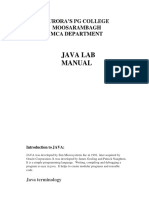Department of Computer Science and Engineering, SMVEC
Ex. No. 1 (a) Simple Program: Factorial of a given Number Date:
Aim:
To write a simple JAVA program for finding factorial of a given number.
Algorithm:
Step1: Start
Step2: Read input of n value
Step3: f=1
Step4: i=1
Step5: for i=1 to n
Step6: f = f * i
Step7: Next i
Step8: Print output factorial
Step9: Stop
Program:
//Program for finding Factorial of a given number
import java.io.DataInputStream;
import java.io.IOException;
public class forloopex1 {
public static void main(String ar[])throws IOException
{
DataInputStream di = new DataInputStream(System.in);
int i,n;
System.out.println("Enter value of n");
n= Integer.parseInt(di.readLine());
int f=1;
for(i=1;i<=n;i++)
{
f = f * i;
}
System.out.println("The Factorial = "+f);
}
}
Input / Output:
Enter value of n
5
The Factorial = 120
Result:
Thus the program for finding factorial of a given number is successfully executed.
1
Programming in JAVA Laboratory
Department of Computer Science and Engineering, SMVEC
Ex. No. 1 (b) Simple Program: Check prime of not Date:
Aim:
To write a simple JAVA program for checking whether a given number is prime or not.
Algorithm:
Program:
//Program for finding checking prime or not
2
Programming in JAVA Laboratory
Department of Computer Science and Engineering, SMVEC
Input / Output:
Particulars Max Mark Mark Secured
Program and Execution 15
Viva 10
Total 25
Result:
3
Programming in JAVA Laboratory
Department of Computer Science and Engineering, SMVEC
Ex. No. 2 (a) Implementation of Classes and Objects Date:
Aim:
To write a JAVA program for the implementation of Classes and Objects.
Algorithm:
Step1: Start
Step2: Create a class
Step3: Create a method getdata()
Step4: Create another method printdata()
Step5: Close the class
Step6: Open the main class and main() method
Step7: Create object for the class
Step8: Call getdata() and printdata() using the object
Step9: Close the main program
Step10: Stop
Program:
//Program for the implementation of Classes and Objects
import java.io.*;
class addproc
{
int a,b;
void getdata()throws IOException
{
DataInputStream di = new DataInputStream(System.in);
System.out.println("Enter a,b values");
a = Integer.parseInt(di.readLine());
b = Integer.parseInt(di.readLine());
}
void printresult()
{
System.out.println("The addition = "+(a+b));
}
}
class classex1
{
public static void main(String ar[])throws IOException
{
addproc a1 = new addproc();
a1.getdata();
a1.printresult();
}
}
4
Programming in JAVA Laboratory
Department of Computer Science and Engineering, SMVEC
Input / Output:
Enter a, b values
100
200
The addition = 300
Result:
Thus the program for the implementation of Class and Object is successfully executed.
5
Programming in JAVA Laboratory
Department of Computer Science and Engineering, SMVEC
Ex. No. 2 (b) Implementation of Classes and Objects Date:
using Constructors
Aim:
To write a JAVA program for the implementation of Classes and Objects using
Constructors.
Algorithm:
Program:
//Program for the implementation of Classes and Objects using Constructors
6
Programming in JAVA Laboratory
Department of Computer Science and Engineering, SMVEC
Input / Output:
Particulars Max Mark Mark Secured
Program and Execution 15
Viva 10
Total 25
Result:
7
Programming in JAVA Laboratory
Department of Computer Science and Engineering, SMVEC
Ex. No. 3 (a) Implementation of Single Inheritance Date:
Aim:
To write a JAVA program for the implementation of Single Inheritance.
Algorithm:
Step1: Start
Step2: Create B class
Step3: Create a method getA()
Step4: Close the A class
Step5: Create another class B
Step6: Create a method getB()
Step7: Create another method printB()
Step8: Close the B class
Step9: Open the main class and main() method
Step10: Create object for the B class
Step11: Call getA() and printB() using the object
Step12: Close the main program
Step13: Stop
Program:
//Program for the implementation of Single Inheritance
class A
{
int a;
A()
{
a=25;
}
void getA()
{
a=50;
}
}
class B extends A
{
int b;
B()
{
b = 100;
}
void getB()
{
b= 150;
}
void printB()
{
b= a+b;
System.out.println(b);
}
8
Programming in JAVA Laboratory
Department of Computer Science and Engineering, SMVEC
class single1
{
public static void main(String ar[])
{
B b1 = new B();
b1.getA();
b1.printB();
}
}
Input / Output:
150
Result:
Thus the program for the implementation of Single Inheritance is successfully executed.
9
Programming in JAVA Laboratory
Department of Computer Science and Engineering, SMVEC
Ex. No. 3 (b) Implementation of Hierarchical Inheritance Date:
Aim:
To write a JAVA program for the implementation of Hierarchical Inheritance.
Algorithm:
Program:
//Program for the implementation of Hierarchical Inheritance
10
Programming in JAVA Laboratory
Department of Computer Science and Engineering, SMVEC
11
Programming in JAVA Laboratory
Department of Computer Science and Engineering, SMVEC
Input / Output:
Particulars Max Mark Mark Secured
Program and Execution 15
Viva 10
Total 25
Result:
12
Programming in JAVA Laboratory
Department of Computer Science and Engineering, SMVEC
Implementation of Multithreading
Ex. No. 4 (a) Date:
using Thread class
Aim:
To write a JAVA program for the implementation of Multithreading using Thread Class.
Algorithm:
Step1: Start
Step2: Create threadex2 class and inherit from Thread class
Step3: Create a method run() which is the actual class
Step4: Close the threadex2 class
Step5: Open the main class and main() method
Step9: Create 3 objects for the threadex2 class
Step10: Close the main program
Step11: Stop
Program:
//Program for the implementation of Multi Threading using Thread class
class threadex2 extends Thread
{ String s;
threadex2(String s)
{
this.s = s;
start();
}
public void run()
{
for(int i=1;i<=3;i++)
{
System.out.println(s+" - "+i);
try {
Thread.sleep(200);
}catch(InterruptedException ie) {System.out.println("excep in thread");}
} } }
class multithreadclass1
{
public static void main(String ar[])
{
threadex2 t1 = new threadex2("ONE");
threadex2 t2 = new threadex2("TWO");
threadex2 t3 = new threadex2("THREE");
for(int i=1;i<=3;i++)
{
System.out.println("Main - "+i);
try {
Thread.sleep(400);
}catch(InterruptedException ie) {System.out.println("excep in main");}
} } }
13
Programming in JAVA Laboratory
Department of Computer Science and Engineering, SMVEC
Input / Output:
Main – 1
ONE – 1
TWO – 1
THREE – 1
Main – 2
TWO – 2
ONE – 2
THREE – 2
Main – 3
ONE – 3
THREE – 3
TWO - 3
Result:
Thus the program for the implementation of Multi Threading using Thread class is successfully
executed.
14
Programming in JAVA Laboratory
Department of Computer Science and Engineering, SMVEC
Implementation of Multithreading
Ex. No. 4 (b) Date:
using Runnable Interface
Aim:
To write a JAVA program for the implementation of Multithreading using Runnable
interface.
Algorithm:
Program:
//Program for the implementation of Multi Threading using Runnable Interface.
15
Programming in JAVA Laboratory
Department of Computer Science and Engineering, SMVEC
Input / Output:
Particulars Max Mark Mark Secured
Program and Execution 15
Viva 10
Total 25
Result:
16
Programming in JAVA Laboratory
Department of Computer Science and Engineering, SMVEC
Ex. No. 5 (a) Implementation of Collection Framework using Date:
LinkedList class
Aim:
To write a JAVA program for the implementation of Collection Framework using LinkedList
class.
Algorithm:
Step1: Start of first program
Step2: Create an object for LinkedList class
Step3: Add the elements using add() method
Step4: Print all the elements using Iterator.next() method.
Step5: Stop
Step9: Start of second program
Step10: Create an object for LinkedList class
Step11: Call all the methods supported by LinkedList object
Step12:Stop
Program:
//1. Program for the implementation of LinkedList using Collection Framework
import java.util.*;
public class collLinkedList1
{
public static void main(String args[])
{
LinkedList<String> al=new LinkedList<String>();
al.add("Ravi");
al.add("Vijay");
al.add("Ravi");
al.add("Ajay");
Iterator<String> itr=al.iterator();
while(itr.hasNext())
{
System.out.println(itr.next());
}
}
}
//2. Program for the implementation of methods in Linked List.
import java.util.*;
class collListmethods1 {
public static void main(String[] args) {
// Creating list using the LinkedList class
List<Integer> numbers = new LinkedList<>();
// Add elements to the list
numbers.add(100);
numbers.add(50);
17
Programming in JAVA Laboratory
Department of Computer Science and Engineering, SMVEC
numbers.add(25);
numbers.add(7);
numbers.add(22);
System.out.println("List: " + numbers);
// Access element from the list
int number = numbers.get(2);
System.out.println("Accessed Element: " + number);
// Using the indexOf() method
int index = numbers.indexOf(2);
System.out.println("Position of 2 is " + (index+1));
// Remove element from the list
int removedNumber = numbers.remove(1);
System.out.println("Removed Element: " + removedNumber);
numbers.set(2, 10);
System.out.println("List: " + numbers);
System.out.println("Length of the List = "+numbers.size());
boolean res = numbers.contains(50)?true:false;
System.out.println(res);
numbers.sort(null);
System.out.println("Sorted List: " + numbers);
}
}
Input / Output:
1. Output of the first program:
Entered Elements
Ravi
Vijay
Ravi
Ajay
2. Output of the Second program:
List: [100, 50, 25, 7, 22]
Accessed Element: 25
Position of 2 is 0
Removed Element: 50
List: [100, 25, 10, 22]
Length of the List = 4
false
Sorted List: [10, 22, 25, 100]
Result:
Thus the program for the implementation of LinkedList using Collection Framework.
18
Programming in JAVA Laboratory
Department of Computer Science and Engineering, SMVEC
Ex. No. 5 (b) Implementation of Collection Framework using Date:
TreeSet class
Aim:
To write a JAVA program for the implementation of Collection Framework using TreeSet
class.
Algorithm:
Program:
19
Programming in JAVA Laboratory
Department of Computer Science and Engineering, SMVEC
Input / Output:
Particulars Max Mark Mark Secured
Program and Execution 15
Viva 10
Total 25
Result:
20
Programming in JAVA Laboratory
Department of Computer Science and Engineering, SMVEC
Ex. No. 6 (a) Implementation of Simple Application using Date:
JDBC for Student Database
Aim:
To write a JAVA program for the implementation of simple Application using MySql-Java
connectivity for Student Database.
Algorithm:
Step1: Start
Step2: Create forname() with Java-MySql Driver
Step3: Create a method getConnection() with name of the Database and password
Step4: Create an object for Statement class using con.createStatement()
Step5: Create an object for ResultSet with executeQuery() method
Step9: Print all the records from the ResultSet using next() method
Step10: Close the main program
Step11: Stop
Program:
//Program for the implementation of MySQL – JAVA connectivity.
import java.sql.*;
public class dbex1{
public static void main(String args[])
{
try{
Class.forName("com.mysql.cj.jdbc.Driver");
Connection
con=DriverManager.getConnection("jdbc:mysql://localhost:3306/ICsecdb","system","manager");
Statement stmt=con.createStatement();
ResultSet rs=stmt.executeQuery("select * from stud");
System.out.println("Roll Numer\tStud Name");
System.out.println(" -");
while(rs.next())
System.out.println(rs.getInt(1)+" \t\t "+rs.getString(2));
con.close();
}catch(Exception e){ System.out.println(e);}
}
}
21
Programming in JAVA Laboratory
Department of Computer Science and Engineering, SMVEC
Input / Output:
Result:
Thus the program for the implementation of MySql-Java connectivity for Student Database is
successfully executed.
22
Programming in JAVA Laboratory
Department of Computer Science and Engineering, SMVEC
Ex. No. 6 (b) Implementation of Simple Application using Date:
JDBC for Employee Database
Aim:
To write a JAVA program for the implementation of simple Application using MySql-Java
connectivity for Employee Database.
Algorithm:
Program:
23
Programming in JAVA Laboratory
Department of Computer Science and Engineering, SMVEC
Input / Output:
Particulars Max Mark Mark Secured
Program and Execution 15
Viva 10
Total 25
Result:
24
Programming in JAVA Laboratory
Department of Computer Science and Engineering, SMVEC
Ex. No. 7 Implementation of Student Application with ADD, Date:
EDIT, DELETE using JDBC
Aim:
To write a JAVA program for the implementation of Student Application using MySql-Java
connectivity with ADD, EDIT, DELETE options.
Algorithm:
Step1: Start
Step2: Create forname() with Java-MySql Driver
Step3: Create a method getConnection() with name of the Database and password
Step4: Create an object for Statement class using con.createStatement()
Step5: Create an object for PreparedStatement with prepareStatement() method
Step9: Print all the records from the ResultSet using next() method
Step10: Close the main program
Step11: Stop
Program:
import java.awt.*;
import javax.swing.*;
import java.awt.event.*;
import java.sql.*;
public class JDBCexSwing2 extends JFrame implements ActionListener
{
JLabel lblRollno,lblName;
JTextField txtRollno,txtName;
JButton delete1, save,exit, update1;
JDBCexSwing2()
{
super("JDBC and Swing Example");
//JPanel panel = new JPanel(new GridLayout(3,3));
JPanel panel = new JPanel(true);
panel.setLayout(new GridLayout(10,10));
lblRollno= new JLabel("RollNo");
panel.add(lblRollno);
txtRollno= new JTextField();
panel.add(txtRollno);
lblName= new JLabel("Name");
panel.add(lblName);
txtName= new JTextField();
panel.add(txtName);
save = new JButton("Save");
panel.add(save);
save.addActionListener(this);
delete1 = new JButton("Delete");
panel.add(delete1);
delete1.addActionListener(this);
25
Programming in JAVA Laboratory
Department of Computer Science and Engineering, SMVEC
update1 = new JButton("Update");
panel.add(update1);
update1.addActionListener(this);
exit = new JButton("Exit");
panel.add(exit);
exit.addActionListener(this);
add(panel);
setSize(500, 400);
this.setVisible(true);
}
public void actionPerformed(ActionEvent e)
{
if(e.getSource()==save)
{
AddStudent();
JOptionPane.showMessageDialog(this, "Student information updated
successfully");
}
else if(e.getSource()==delete1)
{
deleteStudent();
JOptionPane.showMessageDialog(this, "Student information deleted successfully");
}
else if(e.getSource()==update1)
{
updateStudent();
JOptionPane.showMessageDialog(this, "Student information updated
successfully");
}
else if(e.getSource()==exit)
{
this.dispose();
}
}
public void deleteStudent()
{
try
{
Class.forName("com.mysql.cj.jdbc.Driver");
Connection con1 =
DriverManager.getConnection("jdbc:mysql://localhost:3306/ICsecdb","system","manager");
int rollno = Integer.parseInt(txtRollno.getText());
PreparedStatement ps1=con1.prepareStatement("delete from stud where sid=?");
ps1.setInt(1,rollno);
int x = ps1.executeUpdate();
ps1.close();
con1.close();
}
catch (Exception ex)
{
26
Programming in JAVA Laboratory
Department of Computer Science and Engineering, SMVEC
JOptionPane.showMessageDialog(this, "Error");
}
public void updateStudent()
{
try
{
Class.forName("com.mysql.cj.jdbc.Driver");
Connection con2 =
DriverManager.getConnection("jdbc:mysql://localhost:3306/ICsecdb","system","manager");
int rollno = Integer.parseInt(txtRollno.getText());
String name = txtName.getText();
PreparedStatement ps2=con2.prepareStatement("update stud set sname = ? where
sid=?");
ps2.setString(1,name);
ps2.setInt(2,rollno);
int x = ps2.executeUpdate();
ps2.close();
con2.close();
}
catch (Exception ex)
{
JOptionPane.showMessageDialog(this, "Error");
}
}
public void AddStudent()
{
try
{
Class.forName("com.mysql.cj.jdbc.Driver");
Connection con =
DriverManager.getConnection("jdbc:mysql://localhost:3306/ICsecdb","system","manager");
int rollno = Integer.parseInt(txtRollno.getText());
String name = txtName.getText();
PreparedStatement ps=con.prepareStatement("insert into stud values(?,?)");
ps.setInt(1,rollno);//1 specifies the first parameter in the query
ps.setString(2,name);
int x = ps.executeUpdate();
ps.close();
con.close();
}
catch (Exception ex)
{
JOptionPane.showMessageDialog(this, "Error");
}
}
public static void main(String[] args)
27
Programming in JAVA Laboratory
Department of Computer Science and Engineering, SMVEC
{
JDBCexSwing2 ss = new JDBCexSwing2();
ss.setDefaultCloseOperation(JFrame.EXIT_ON_CLOSE);
}
}
Input / Output:
28
Programming in JAVA Laboratory
Department of Computer Science and Engineering, SMVEC
Particulars Max Mark Mark Secured
Program and Execution 15
Viva 10
Total 25
Result:
29
Programming in JAVA Laboratory
Department of Computer Science and Engineering, SMVEC
Ex. No. 8(a) Implementation of FileInputStream and Date:
FileOutputStream using java.io package
Aim:
To write a JAVA program for the implementation of FileInputStream and FileOutputStream
using java.io package.
Algorithm:
Step1: Start
Step2: Create an object for FileInputStream class with the Physical file testout.txt
Step3: Reading the content of the file using read() method
Step4: Close the file using close() method
Step5: Create an object for FileOutputStream class with the Physical file testout.txt
Step9: Writing a content into the file using write() method
Step10: Close the file using close() main program
Step11: Stop
Program:
//a) Program for FileInputStream example
import java.io.*;
public class iofileinputstreamex1
{
public static void main(String args[])
{
try{
FileInputStream fin=new FileInputStream("D:\\testout.txt");
int i=0;
while((i=fin.read())!=-1)
{
System.out.println((char)i);
}
fin.close();
}catch(Exception e){System.out.println(e);}
}
}
Input:
30
Programming in JAVA Laboratory
Department of Computer Science and Engineering, SMVEC
Output:
BME students are very good - yes
// b) Program for FileOutputStream example
import java.io.*;
public class iofileoutputstreamex1 {
public static void main(String args[])throws IOException
{
try{
DataInputStream di = new DataInputStream(System.in);
FileOutputStream fout=new FileOutputStream("D:\\testout.txt");
System.out.println("Enter the string to be written");
String s=di.readLine();
byte b[]=s.getBytes();//converting string into byte array
fout.write(b);
fout.close();
System.out.println("success...");
}catch(Exception e){System.out.println(e);}
}
}
Input:
Enter the string to be written
Smvec
success...
Output:
Result:
Thus the Java program for the implementation of FileInputStream and FileOutputStream has been
executed successfully.
31
Programming in JAVA Laboratory
Department of Computer Science and Engineering, SMVEC
Ex. No. 8(b) Implementation of FileReader and FileWriter Date:
using java.io package
Aim:
To write a JAVA program for the implementation of FileReader and FileWriter using java.io
package.
Algorithm:
Program:
//a) Program for FileReader example
32
Programming in JAVA Laboratory
Department of Computer Science and Engineering, SMVEC
Input:
Output:
// b) Program for FileWriter example
33
Programming in JAVA Laboratory
Department of Computer Science and Engineering, SMVEC
Input:
Output:
Particulars Max Mark Mark Secured
Program and Execution 15
Viva 10
Total 25
Result:
34
Programming in JAVA Laboratory
Department of Computer Science and Engineering, SMVEC
Ex. No. 9(a) Implementation of JAVA application using Date:
Exception Handling
Aim:
To write a JAVA program for the implementation of Exception Handling.
Algorithm:
Step1: Start
Step2: Read a and b values
Step3: c = a / b
Step4: if b is 0 then throw the exception and handling using try..catch blocks
Step5: if b is a non zero then print the result of the division
Step9: Stop
Program:
//Exception handling using Multiple catch blocks
import java.io.*;
public class exceptionhandling1 {
public static void main(String ar[])throws IOException
{
DataInputStream di = new DataInputStream(System.in);
int a, b, c;
System.out.println("Enter value for a");
a = Integer.parseInt(di.readLine());
System.out.println("Enter value for b");
b = Integer.parseInt(di.readLine());
try
{
c = (int) a / b;
System.out.println("Division = "+c);
}
catch(ArrayIndexOutOfBoundsException e)
{
System.out.println(e.getMessage());
}
catch(Exception e)
{
System.out.println(e.getMessage());
}
}
Input / Output:
35
Programming in JAVA Laboratory
Department of Computer Science and Engineering, SMVEC
Enter value for a
10
Enter value for b
0
/ by zero
Result:
Thus the Java program for the implementation of Exception Handling has been executed
successfully.
36
Programming in JAVA Laboratory
Department of Computer Science and Engineering, SMVEC
37
Programming in JAVA Laboratory
Department of Computer Science and Engineering, SMVEC
Ex. No. 9(b) Implementation of JAVA application using Date:
Exception Handling with User Defined Exception
Aim:
To write a JAVA program for the implementation of Exception Handling with User Defined
Exception.
Algorithm:
Program:
38
Programming in JAVA Laboratory
Department of Computer Science and Engineering, SMVEC
Input / Output:
Particulars Max Mark Mark Secured
Program and Execution 15
Viva 10
Total 25
Result:
39
Programming in JAVA Laboratory
Department of Computer Science and Engineering, SMVEC
Ex.No. 10 Implementation of Packages in JAVA Date:
Aim:
To write a JAVA program for the implementation of Packages.
Algorithm:
Step1: Start
Step2: create this bmepack.java in E:/BME/
Step3: Compile this bmepack.java
Step4: Create this packmain.java in E:/
Step5: Compile and execute the packmain.java program
Step9: Stop
Program:
// Step1: create this bmepack.java in E:/BME/
package BME;
public class bmepack
{
public void packex1()
{
System.out.println("Inside the BME class and packex1() method");
}
}
//Step 2: Compile this bmepack.java
//Step 3: Create this packmain.java in E:/
import BME.*;
class packmain
{
public static void main(String ar[])
{
bmepack bc1 = new bmepack();
bc1.packex1();
}
}
// Step 4: Compile and execute the packmain.java program
40
Programming in JAVA Laboratory
Department of Computer Science and Engineering, SMVEC
Input / Output:
E:\BME>javac bmepack.java
E:\BME>cd..
E:\>set classpath=e:/
E:\>javac packmain.java
E:\>java packmain
Inside the BME class and packex1() method
Particulars Max Mark Mark Secured
Program and Execution 15
Viva 10
Total 25
Result:
Thus the Java program for the implementation of Creating Packages and utilizing Packages has
been executed successfully.
41
Programming in JAVA Laboratory





















































































